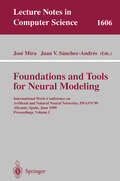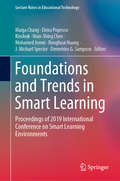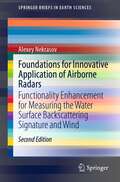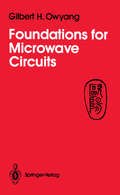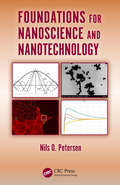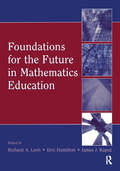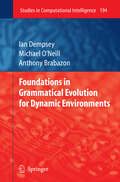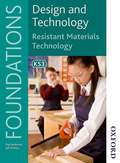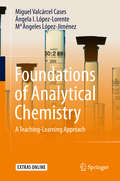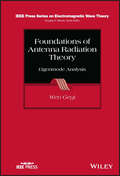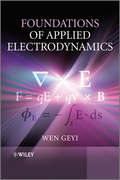- Table View
- List View
Foundations and Practical Applications of Cognitive Systems and Information Processing: Proceedings of the First International Conference on Cognitive Systems and Information Processing, Beijing, China, Dec 2012 (CSIP2012) (Advances in Intelligent Systems and Computing #215)
by Fuchun Sun Dewen Hu Huaping Liu"Foundations and Practical Applications of Cognitive Systems and Information Processing" presents selected papers from the First International Conference on Cognitive Systems and Information Processing, held in Beijing, China on December 15-17, 2012 (CSIP2012). The aim of this conference is to bring together experts from different fields of expertise to discuss the state-of-the-art in artificial cognitive systems and advanced information processing, and to present new findings and perspectives on future development. This book introduces multidisciplinary perspectives on the subject areas of Cognitive Systems and Information Processing, including cognitive sciences and technology, autonomous vehicles, cognitive psychology, cognitive metrics, information fusion, image/video understanding, brain-computer interfaces, visual cognitive processing, neural computation, bioinformatics, etc.The book will be beneficial for both researchers and practitioners in the fields of Cognitive Science, Computer Science and Cognitive Engineering.Fuchun Sun and Huaping Liu are both professors at the Department of Computer Science & Technology, Tsinghua University, China. Dr. Dewen Hu is a professor at the College of Mechatronics and Automation, National University of Defense Technology, Changsha, China.
Foundations and Tools for Neural Modeling: International Work-Conference on Artificial and Natural Neural Networks, IWANN'99, Alicante, Spain, June 2-4, 1999, Proceedings, Volume I (Lecture Notes in Computer Science #1606)
by Jose Mira Juan V. Sanchez-AndresThis book constitutes, together with its compagnion LNCS 1607, the refereed proceedings of the International Work-Conference on Artificial and Natural Neural Networks, IWANN'99, held in Alicante, Spain in June 1999.The 89 revised papers presented were carefully reviewed and selected for inclusion in the book. This volume is devoted to foundational issues of neural computation and tools for neural modeling. The papers are organized in parts on neural modeling: biophysical and structural models; plasticity phenomena: maturing, learning, and memory; and artificial intelligence and cognitive neuroscience.
Foundations and Trends in Smart Learning: Proceedings of 2019 International Conference on Smart Learning Environments (Lecture Notes in Educational Technology)
by Maiga Chang Elvira Popescu Kinshuk Nian-Shing Chen Mohamed Jemni Ronghuai Huang J. Michael Spector Demetrios G. SampsonThis book focuses on the interplay between pedagogy and technology, and their fusion for the advancement of smart learning environments. It discusses various components of this interplay, including learning and assessment paradigms, social factors and policies, emerging technologies, innovative application of mature technologies, transformation of curriculum and teaching behavior, transformation of administration, best infusion practices, and piloting of new ideas.The book provides an archival forum for researchers, academics, practitioners and industry professionals interested and/or engaged in reforming teaching and learning methods by promoting smart learning environments. It also facilitates discussions and constructive dialogue among various stakeholders on the limitations of existing learning environments, the need for reform, innovative uses of emerging pedagogical approaches and technologies, and sharing and promoting best practices, leading to the evolution, design and implementation of smart learning environments.
Foundations for Innovative Application of Airborne Radars: Measuring the Water Surface Backscattering Signature and Wind (SpringerBriefs in Earth Sciences)
by Alexey NekrasovThe ‘wind vector’ – wind speed and direction – is a main meteorological quantity and relevant for air-sea exchange processes. This book explores the use of several airborne microwave instruments, some of which are part of standard aircraft equipment, in determining the local wind vector over water. This is worthwhile as local wind information is usually only available at measurements sites like weather stations and airports, and global wind information from satellites has very coarse resolution and poor temporal coverage – at most a few times daily. In his book, Nekrasov uses known results in a novel way and gives explicit and application-oriented descriptions how to additionally retrieve local wind information from standard airborne microwave instruments. The results presented here are highly valuable for flight operation above the sea (e.g., search-and-rescue) but also for complementing other measurements of atmospheric or oceanic parameters during research flights.
Foundations for Innovative Application of Airborne Radars: Functionality Enhancement for Measuring the Water Surface Backscattering Signature and Wind (SpringerBriefs in Earth Sciences)
by Alexey NekrasovThis book discusses methods for measuring the water surface backscattering signature and estimating the near-surface wind vector over water using airborne radars, in addition to their standard application. Airborne FMCW demonstrator system, Doppler navigation system, airborne weather radar, airborne radar altimeter, and airborne precipitation radar are analyzed in order to be used for that purpose. The radars functionality is enhanced for their operation in a scatterometer mode. A circle flight and/or a rectilinear flight of an aircraft over the water surface is considered depending on the radar design features to perform measurements of the azimuth normalized radar cross section curve of the water surface and/or the near-surface wind speed and direction. Flight recommendations to perform measurements along with algorithms for measuring the water surface backscattering signature and for retrieval of the wind speed and direction over water are presented.
Foundations for Microstrip Circuit Design (Wiley - IEEE)
by Terry C. Edwards Michael B. SteerBuilding on the success of the previous three editions, Foundations for Microstrip Circuit Design offers extensive new, updated and revised material based upon the latest research. Strongly design-oriented, this fourth edition provides the reader with a fundamental understanding of this fast expanding field making it a definitive source for professional engineers and researchers and an indispensable reference for senior students in electronic engineering. Topics new to this edition: microwave substrates, multilayer transmission line structures, modern EM tools and techniques, microstrip and planar transmision line design, transmission line theory, substrates for planar transmission lines, Vias, wirebonds, 3D integrated interposer structures, computer-aided design, microstrip and power-dependent effects, circuit models, microwave network analysis, microstrip passive elements, and slotline design fundamentals.
Foundations for Microstrip Circuit Design (Wiley - IEEE)
by Terry C. Edwards Michael B. SteerBuilding on the success of the previous three editions, Foundations for Microstrip Circuit Design offers extensive new, updated and revised material based upon the latest research. Strongly design-oriented, this fourth edition provides the reader with a fundamental understanding of this fast expanding field making it a definitive source for professional engineers and researchers and an indispensable reference for senior students in electronic engineering. Topics new to this edition: microwave substrates, multilayer transmission line structures, modern EM tools and techniques, microstrip and planar transmision line design, transmission line theory, substrates for planar transmission lines, Vias, wirebonds, 3D integrated interposer structures, computer-aided design, microstrip and power-dependent effects, circuit models, microwave network analysis, microstrip passive elements, and slotline design fundamentals.
Foundations for Microwave Circuits
by Gilbert H. OwyangWhile many articles have been written on microwave devices, a great majority of them are prepared for specialists dealing in specific aspects of microwave engineering. At the same time, material at a fundamental level in tutorial form is extremely limited, especially for stu dents who need to acquire basic knowledge in the field. Individuals seeking to gain a prelim inary understanding of microwave circuits are usually relegated with little success to the end less search from one reference source to another. For non-experts, sequential derivations of basic relations are rarely available and extremely difficult to locate. The purpose of this volume is to collect in one place the essential fundamental principles for a group of microwave devices. The chosen devices are those which form the basic modules found in practical microwave systems. Thus, these devices provide the crucial build ing blocks in common microwave systems, and their inherent characteristics are also the basis of some of the fundamental concepts in more complex devices. The material is presented in a continuous, self-contained manner. With the appropriate background, readers should be able to follow and understand the contents without the need for additional references.
Foundations for Nanoscience and Nanotechnology
by Nils O. PetersenDo you ever wonder why size is so important at the scale of nanosystems? Do you want to understand the fundamental principles that govern the properties of nanomaterials? Do you want to establish a foundation for working in the field of nanoscience and nanotechnology? Then this book is written with you in mind. Foundations for Nanoscience and Nanotechnology provides some of the physical chemistry needed to understand why properties of small systems differ both from their constituent molecular entities and from the corresponding bulk matter. This is not a book about nanoscience and nanotechnology, but rather an exposition of basic knowledge required to understand these fields. The collection of topics makes it unique, and these topics include: The concept of quantum confinement and its consequences for electronic behaviour (Part II) The importance of surface thermodynamics for activity and interactions of nanoscale systems (Part III) The need to consider fluctuations as well as mean properties in small systems (Part IV) The interaction of light with matter and specific applications of spectroscopy and microscopy (Part V) This book is written for senior undergraduates or junior graduate students in science or engineering disciplines who wish to learn about or work in the areas of nanoscience and nanotechnology, but who do not have the requisite background in chemistry or physics. It may also be useful as a refresher or summary text for chemistry and physics students since the material is focused on those aspects of quantum mechanics, thermodynamics, and statistical mechanics that specifically relate to the size of objects.
Foundations for Nanoscience and Nanotechnology
by Nils O. PetersenDo you ever wonder why size is so important at the scale of nanosystems? Do you want to understand the fundamental principles that govern the properties of nanomaterials? Do you want to establish a foundation for working in the field of nanoscience and nanotechnology? Then this book is written with you in mind. Foundations for Nanoscience and Nanotechnology provides some of the physical chemistry needed to understand why properties of small systems differ both from their constituent molecular entities and from the corresponding bulk matter. This is not a book about nanoscience and nanotechnology, but rather an exposition of basic knowledge required to understand these fields. The collection of topics makes it unique, and these topics include: The concept of quantum confinement and its consequences for electronic behaviour (Part II) The importance of surface thermodynamics for activity and interactions of nanoscale systems (Part III) The need to consider fluctuations as well as mean properties in small systems (Part IV) The interaction of light with matter and specific applications of spectroscopy and microscopy (Part V) This book is written for senior undergraduates or junior graduate students in science or engineering disciplines who wish to learn about or work in the areas of nanoscience and nanotechnology, but who do not have the requisite background in chemistry or physics. It may also be useful as a refresher or summary text for chemistry and physics students since the material is focused on those aspects of quantum mechanics, thermodynamics, and statistical mechanics that specifically relate to the size of objects.
Foundations for the Future in Mathematics Education
by Richard A. Lesh Eric Hamilton James J. KaputThe central question addressed in Foundations for the Future in Mathematics Education is this: What kind of understandings and abilities should be emphasized to decrease mismatches between the narrow band of mathematical understandings and abilities that are emphasized in mathematics classrooms and tests, and those that are needed for success beyond school in the 21st century? This is an urgent question. In fields ranging from aeronautical engineering to agriculture, and from biotechnologies to business administration, outside advisors to future-oriented university programs increasingly emphasize the fact that, beyond school, the nature of problem-solving activities has changed dramatically during the past twenty years, as powerful tools for computation, conceptualization, and communication have led to fundamental changes in the levels and types of mathematical understandings and abilities that are needed for success in such fields. For K-12 students and teachers, questions about the changing nature of mathematics (and mathematical thinking beyond school) might be rephrased to ask: If the goal is to create a mathematics curriculum that will be adequate to prepare students for informed citizenship—as well as preparing them for career opportunities in learning organizations, in knowledge economies, in an age of increasing globalization—how should traditional conceptions of the 3Rs be extended or reconceived? Overall, this book suggests that it is not enough to simply make incremental changes in the existing curriculum whose traditions developed out of the needs of industrial societies. The authors, beyond simply stating conclusions from their research, use results from it to describe promising directions for a research agenda related to this question. The volume is organized in three sections: *Part I focuses on naturalistic observations aimed at clarifying what kind of “mathematical thinking” people really do when they are engaged in “real life” problem solving or decision making situations beyond school. *Part II shifts attention toward changes that have occurred in kinds of elementary-but-powerful mathematical concepts, topics, and tools that have evolved recently—and that could replace past notions of “basics” by providing new foundations for the future. This section also initiates discussions about what it means to “understand” the preceding ideas and abilities. *Part III extends these discussions about meaning and understanding—and emphasizes teaching experiments aimed at investigating how instructional activities can be designed to facilitate the development of the preceding ideas and abilities. Foundations for the Future in Mathematics Education is an essential reference for researchers, curriculum developers, assessment experts, and teacher educators across the fields of mathematics and science education.
Foundations for the Future in Mathematics Education
by Richard A. Lesh; Eric Hamilton; James J. KaputThe central question addressed in Foundations for the Future in Mathematics Education is this: What kind of understandings and abilities should be emphasized to decrease mismatches between the narrow band of mathematical understandings and abilities that are emphasized in mathematics classrooms and tests, and those that are needed for success beyond school in the 21st century? This is an urgent question. In fields ranging from aeronautical engineering to agriculture, and from biotechnologies to business administration, outside advisors to future-oriented university programs increasingly emphasize the fact that, beyond school, the nature of problem-solving activities has changed dramatically during the past twenty years, as powerful tools for computation, conceptualization, and communication have led to fundamental changes in the levels and types of mathematical understandings and abilities that are needed for success in such fields. For K-12 students and teachers, questions about the changing nature of mathematics (and mathematical thinking beyond school) might be rephrased to ask: If the goal is to create a mathematics curriculum that will be adequate to prepare students for informed citizenship—as well as preparing them for career opportunities in learning organizations, in knowledge economies, in an age of increasing globalization—how should traditional conceptions of the 3Rs be extended or reconceived? Overall, this book suggests that it is not enough to simply make incremental changes in the existing curriculum whose traditions developed out of the needs of industrial societies. The authors, beyond simply stating conclusions from their research, use results from it to describe promising directions for a research agenda related to this question. The volume is organized in three sections: *Part I focuses on naturalistic observations aimed at clarifying what kind of “mathematical thinking” people really do when they are engaged in “real life” problem solving or decision making situations beyond school. *Part II shifts attention toward changes that have occurred in kinds of elementary-but-powerful mathematical concepts, topics, and tools that have evolved recently—and that could replace past notions of “basics” by providing new foundations for the future. This section also initiates discussions about what it means to “understand” the preceding ideas and abilities. *Part III extends these discussions about meaning and understanding—and emphasizes teaching experiments aimed at investigating how instructional activities can be designed to facilitate the development of the preceding ideas and abilities. Foundations for the Future in Mathematics Education is an essential reference for researchers, curriculum developers, assessment experts, and teacher educators across the fields of mathematics and science education.
Foundations in Grammatical Evolution for Dynamic Environments (Studies in Computational Intelligence #194)
by Ian Dempsey Michael O'Neill Anthony BrabazonDynamic environments abound, encompassing many real-world problems in fields as diverse as finance, engineering, biology and business. A vibrant research literature has emerged which takes inspiration from evolutionary processes to develop problem-solvers for these environments. 'Foundations in Grammatical Evolution for Dynamic Environments' is a cutting edge volume illustrating current state of the art in applying grammar-based evolutionary computation to solve real-world problems in dynamic environments. The book provides a clear introduction to dynamic environments and the types of change that can occur. This is followed by a detailed description of evolutionary computation, concentrating on the powerful Grammatical Evolution methodology. It continues by addressing fundamental issues facing all Evolutionary Algorithms in dynamic problems, such as how to adapt and generate constants, how to enhance evolvability and maintain diversity. Finally, the developed methods are illustrated with application to the real-world dynamic problem of trading on financial time-series. The book was written to be accessible to a wide audience and should be of interest to practitioners, academics and students, who are seeking to apply grammar-based evolutionary algorithms to solve problems in dynamic environments. 'Foundations in Grammatical Evolution for Dynamic Environments' is the second book dedicated to the topic of Grammatical Evolution.
Foundations in Sound Design for Embedded Media: A Multidisciplinary Approach (Sound Design)
by Michael FilimowiczThis volume provides a comprehensive introduction to foundational topics in sound design for embedded media, such as physical computing; interaction design; auditory displays and data sonification; speech synthesis; wearables; smart objects and instruments; user experience; toys and playful tangible objects; and the new sensibilities entailed in expanding the concept of sound design to encompass the totality of our surroundings. The reader will gain a broad understanding of the key concepts and practices that define sound design for its use in computational products and design. The chapters are written by international authors from diverse backgrounds who provide multidisciplinary perspectives on sound in its many embedded forms. The volume is designed as a textbook for students and teachers, as a handbook for researchers in sound, programming and design, and as a survey of key trends and ideas for practitioners interested in exploring the boundaries of their profession.
Foundations in Sound Design for Embedded Media: A Multidisciplinary Approach (Sound Design)
by Michael FilimowiczThis volume provides a comprehensive introduction to foundational topics in sound design for embedded media, such as physical computing; interaction design; auditory displays and data sonification; speech synthesis; wearables; smart objects and instruments; user experience; toys and playful tangible objects; and the new sensibilities entailed in expanding the concept of sound design to encompass the totality of our surroundings. The reader will gain a broad understanding of the key concepts and practices that define sound design for its use in computational products and design. The chapters are written by international authors from diverse backgrounds who provide multidisciplinary perspectives on sound in its many embedded forms. The volume is designed as a textbook for students and teachers, as a handbook for researchers in sound, programming and design, and as a survey of key trends and ideas for practitioners interested in exploring the boundaries of their profession.
Foundations in Sound Design for Interactive Media: A Multidisciplinary Approach (Sound Design)
by Michael FilimowiczThis volume provides a comprehensive introduction to foundational topics in sound design for interactive media, such as gaming and virtual reality; compositional techniques; new interfaces; sound spatialization; sonic cues and semiotics; performance and installations; music on the web; augmented reality applications; and sound producing software design. The reader will gain a broad understanding of the key concepts and practices that define sound design for its use in computational media and design. The chapters are written by international authors from diverse backgrounds who provide multidisciplinary perspectives on sound in its interactive forms. The volume is designed as a textbook for students and teachers, as a handbook for researchers in sound, design and media, and as a survey of key trends and ideas for practitioners interested in exploring the boundaries of their profession.
Foundations in Sound Design for Interactive Media: A Multidisciplinary Approach (Sound Design)
by Michael FilimowiczThis volume provides a comprehensive introduction to foundational topics in sound design for interactive media, such as gaming and virtual reality; compositional techniques; new interfaces; sound spatialization; sonic cues and semiotics; performance and installations; music on the web; augmented reality applications; and sound producing software design. The reader will gain a broad understanding of the key concepts and practices that define sound design for its use in computational media and design. The chapters are written by international authors from diverse backgrounds who provide multidisciplinary perspectives on sound in its interactive forms. The volume is designed as a textbook for students and teachers, as a handbook for researchers in sound, design and media, and as a survey of key trends and ideas for practitioners interested in exploring the boundaries of their profession.
Foundations in Sound Design for Linear Media: A Multidisciplinary Approach (Sound Design)
by Michael FilimowiczThis volume provides a comprehensive introduction to foundational topics in sound design for linear media, such as listening and recording; audio postproduction; key musical concepts and forms such as harmony, conceptual sound design, electronica, soundscape, and electroacoustic composition; the audio commons; and sound’s ontology and phenomenology. The reader will gain a broad understanding of the key concepts and practices that define sound design for its use with moving images as well as important forms of composed sound. The chapters are written by international authors from diverse backgrounds who provide multidisciplinary perspectives on sound in its linear forms. The volume is designed as a textbook for students and teachers, as a handbook for researchers in sound, media and experience, and as a survey of key trends and ideas for practitioners interested in exploring the boundaries of their profession.
Foundations in Sound Design for Linear Media: A Multidisciplinary Approach (Sound Design)
by Michael FilimowiczThis volume provides a comprehensive introduction to foundational topics in sound design for linear media, such as listening and recording; audio postproduction; key musical concepts and forms such as harmony, conceptual sound design, electronica, soundscape, and electroacoustic composition; the audio commons; and sound’s ontology and phenomenology. The reader will gain a broad understanding of the key concepts and practices that define sound design for its use with moving images as well as important forms of composed sound. The chapters are written by international authors from diverse backgrounds who provide multidisciplinary perspectives on sound in its linear forms. The volume is designed as a textbook for students and teachers, as a handbook for researchers in sound, media and experience, and as a survey of key trends and ideas for practitioners interested in exploring the boundaries of their profession.
Foundations KS3: Resistant Materials Technology (PDF)
by Paul Anderson Jeff Draisey'Design and Technology Foundations' student books are matched to the KS3 assessment criteria and programme of study, with engaging content and activities to help develop the design skills and knowledge required at Key Stage 3 and beyond.
Foundations of Airline Finance: Methodology and Practice
by Bijan VasighFoundations of Airline Finance: Methodology and Practice is a textbook that comprehensively covers, at a basic level, all aspects of the subject, bringing together many of the numerous and informative articles and institutional developments that have characterized the field of airline finance in the previous two decades. In the early chapters, the reader is introduced to the elementary theoretical foundations that underpin the role of finance in the airline industry. Critical topics, such as the time value of money, the notion of risk and return, and the complex nature of costs (fixed, semi-fixed, variable, and marginal) are discussed and illustrated with concrete examples. This is followed by an in-depth presentation of the role of accounting in airlines. Ratio analysis is used to further analyze airline financial statements. Airline industry specific metrics, such as cost per available seat mile (CASM) and revenue per revenue passenger mile (RRPM), are covered. The role of capital and asset management is then explained in the following chapters. The final chapters of the text present some important practical applications of the theoretical ideas presented earlier; these applications include hedging, the buy versus lease decision for aircraft and the question of the valuation of assets (mainly aircraft). Moreover, specific methods for actually calculating internal valuation are presented and evaluated. Foundations of Airline Finance: Methodology and Practice will be of greatest value to students who are contemplating entering financial management in the air transportation industry; however, the text will also serve as an accessible and comprehensive reference for industry professionals.
Foundations of Analytical Chemistry: A Teaching–Learning Approach
by Miguel Valcárcel Cases Ángela I. López-Lorente Ma Ángeles López-JiménezThis book offers a completely new approach to learning and teaching the fundamentals of analytical chemistry. It summarizes 250 basic concepts of the field on the basis of slides. Each of the nine chapters offers the following features:• Introduction: Summary. General scheme. Teaching objectives.• Text containing the explanation of each slide.• Recommended and commented bibliography.• Questions to be answered.• Slides. A distinct feature of this novel book is its focus on the fundamental concepts and essential principles of analytical chemistry, which sets it apart from other books presenting descriptive overviews of methods and techniques.
Foundations of Antenna Radiation Theory: Eigenmode Analysis (IEEE Press Series on Electromagnetic Wave Theory)
by Wen GeyiFoundations of Antenna Radiation Theory Understand the theory and function of wireless antennas with this comprehensive guide As wireless technology continues to develop, understanding of antenna properties and performance will only become more critical. Since antennas can be understood as junctions of waveguides, eigenmode analysis—the foundation of waveguide theory, concerned with the unexcited states of systems and their natural resonant characteristics—promises to be a crucial frontier in the study of antenna theory. Foundations of Antenna Radiation Theory incorporates the modal analysis, generic antenna properties and design methods discovered or developed in the last few decades, not being reflected in most antenna books, into a comprehensive introduction to the theory of antennas. This book puts readers into conversation with the latest research and situates students and researchers at the cutting edge of an important field of wireless technology. The book also includes: Detailed discussions of the solution methods for Maxwell equations and wave equations to provide a theoretical foundation for electromagnetic analysis of antennas Recent developments for antenna radiation in closed and open space, modal analysis and field expansions, dyadic Green’s functions, time-domain theory, state-of-the-art antenna array synthesis methods, wireless power transmission systems, and more Innovative material derived from the author’s own research Foundations of Antenna Radiation Theory is ideal for graduate or advanced undergraduate students studying antenna theory, as well as for reference by researchers, engineers, and industry professionals in the areas of wireless technology.
Foundations of Antenna Radiation Theory: Eigenmode Analysis (IEEE Press Series on Electromagnetic Wave Theory)
by Wen GeyiFoundations of Antenna Radiation Theory Understand the theory and function of wireless antennas with this comprehensive guide As wireless technology continues to develop, understanding of antenna properties and performance will only become more critical. Since antennas can be understood as junctions of waveguides, eigenmode analysis—the foundation of waveguide theory, concerned with the unexcited states of systems and their natural resonant characteristics—promises to be a crucial frontier in the study of antenna theory. Foundations of Antenna Radiation Theory incorporates the modal analysis, generic antenna properties and design methods discovered or developed in the last few decades, not being reflected in most antenna books, into a comprehensive introduction to the theory of antennas. This book puts readers into conversation with the latest research and situates students and researchers at the cutting edge of an important field of wireless technology. The book also includes: Detailed discussions of the solution methods for Maxwell equations and wave equations to provide a theoretical foundation for electromagnetic analysis of antennas Recent developments for antenna radiation in closed and open space, modal analysis and field expansions, dyadic Green’s functions, time-domain theory, state-of-the-art antenna array synthesis methods, wireless power transmission systems, and more Innovative material derived from the author’s own research Foundations of Antenna Radiation Theory is ideal for graduate or advanced undergraduate students studying antenna theory, as well as for reference by researchers, engineers, and industry professionals in the areas of wireless technology.
Foundations of Applied Electrodynamics
by Wen GeyiFoundations of Applied Electrodynamics takes a fresh look at the essential concepts and methods of electrodynamics as a whole, uniting the most relevant contemporary topics under a common mathematical framework. It contains clear explanations of high-level concepts as well as the mutual relationships between the essential ideas of electromagnetic theory. Starting with the fundamentals of electrodynamics, it methodically covers a wide spectrum of research and applications that stem from electromagnetic phenomena, before concluding with more advanced topics such as quantum mechanics. Includes new advances and methodologies in applied electrodynamics, and provides the whole picture of the theory of electrodynamics in most active areas of engineering applications Systematically deals with eigenvalue problems, integral equation formulations and transient phenomena in various areas of applied electrodynamics Introduces the complete theory of spherical vector wave functions, and presents the upper bounds of the product of gain and bandwidth for an arbitrary antenna Presents the field approach to multiple antenna system, which provides a theoretical tool for the prediction of channel models of MIMO, and is also the basis of wireless power transmission system One of the first books on electromagnetics that contains the general theory of relativity, which is needed in the design of mobile systems such as global positioning system (GPS) By summarising both engineering and theoretical electromagnetism in one volume, this book is an essential reference for practicing engineers, as well as a guide for those who wish to advance their analytical techniques for studying applied electrodynamics.

